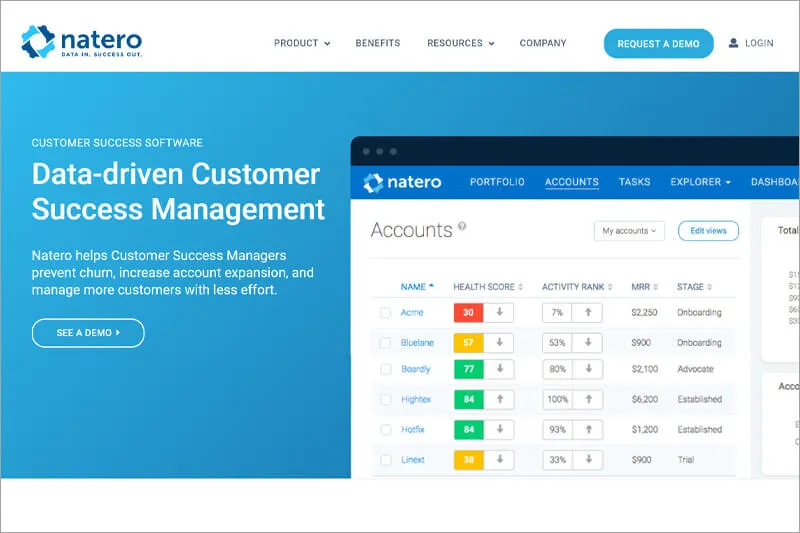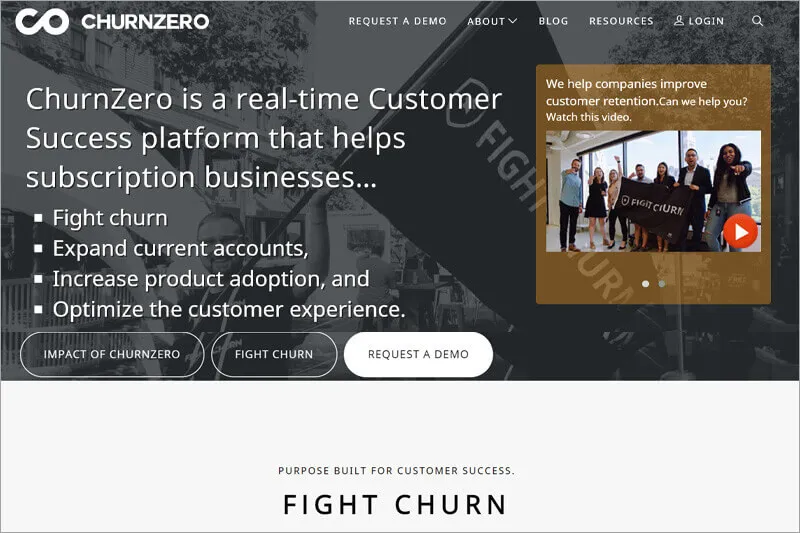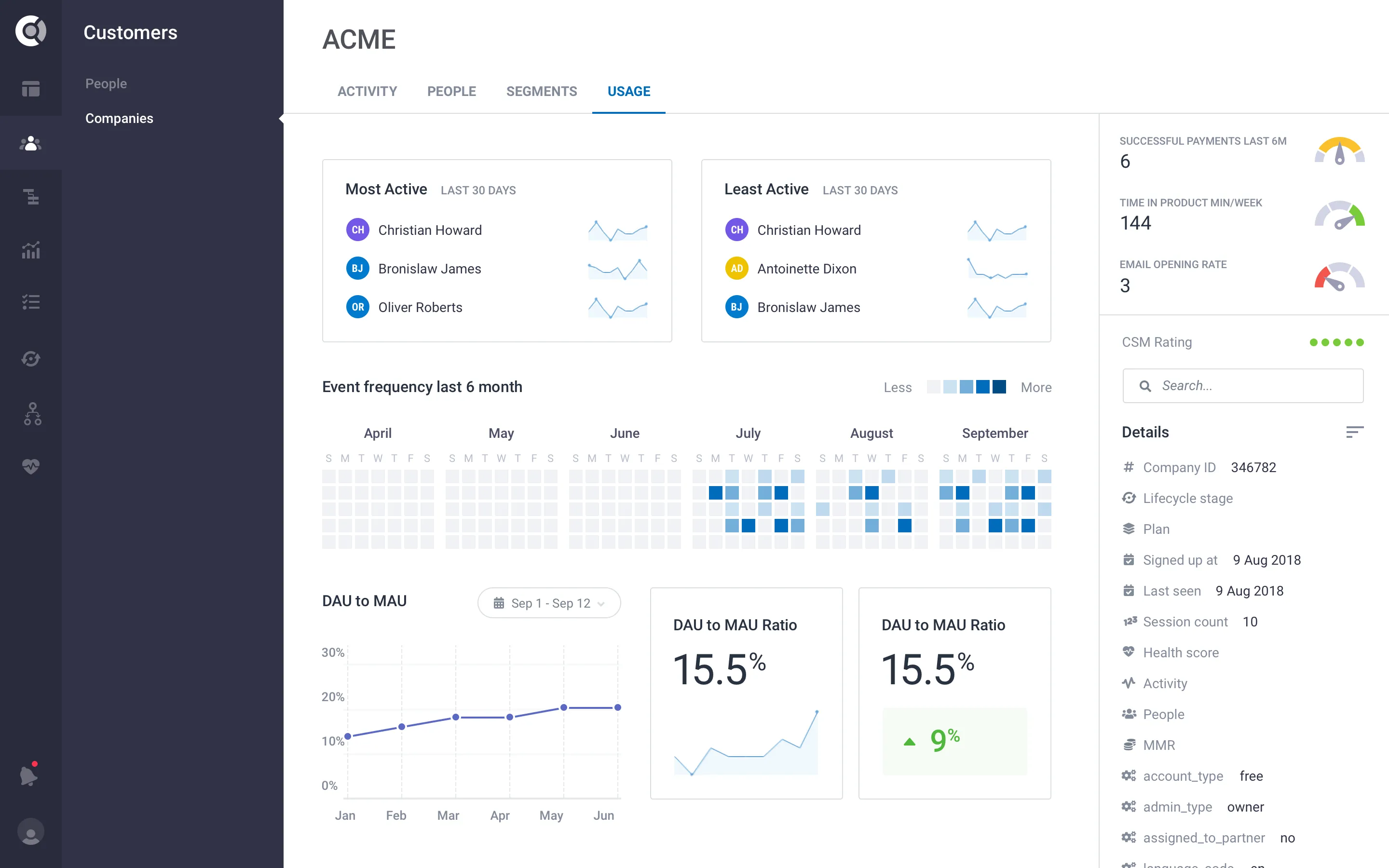Pro Tips on Choosing a Customer Success Solution for SaaS

You have a great product. You provide great support. But one day, you receive notice that your customer is not planning on renewing.
What happened? What warning signs did you miss?
What can you, as a customer success manager, do to be sure that a) your product is being utilized to the fullest and b) each effort you make for the client contributes towards your goal of improving customer retention?
The answer here may be a customer success solution.
Table of Contents
What is a Customer Success Solution?
Marketers have their marketing automation platforms and Sales has their customer relationship management tools. So why wouldn’t customer success managers have their own secret weapon to support their goal of helping customers get the most business value out of their solutions and services?
A customer success solution (or customer success software) is a tool that provides a 360-degree view of the entire customer relationship throughout the entire customer lifecycle.
What this means is that you will have all of your customer data consolidated in one place where you’ll have both insights into customer activity and access to each calculated customer health score.
This would include all of your current communication channels such as email, live chat, support tickets, CRM, and more!
This also means you can visualize the big customer picture without having to spend countless hours checking your various data sources to understand your customer history and current status.
What are the Benefits of Having a Customer Success Solution?
Customers are the heart of any growing business. And if you work in SaaS, the customer is the one with the upper hand in the relationship. This is why it’s important to maintain good customer health throughout the entire customer lifecycle.
But how can you properly monitor and measure each customer interaction and accurately predict if and when a customer will continue with your product or services? Or how would you know if there is an opportunity for growth?
Here is a little metaphor for you. Customer success teams operate a little bit like a doctor’s office. They have constant check-ins with their clients, they prescribe different remedies to solve problems, and they are very interested in “taking the customers’ temperature”, so to say.
Luckily, this is exactly what customer success software can do for customer success managers.
And it’s not just beneficial for customer success teams. Sales teams also want their customer success partners to have a great customer success solution in place to make sure that they understand what happens after the handoff and where they can improve their processes.
It’s a win-win for both your customer acquisition and customer retention strategy. And a little can go a long way when it comes to retention. Just look at this statistic from the Harvard Business Review, for example: “A 5% increase in customer retention can increase company revenue by 25-95%.”
In short, the biggest benefit of having a customer success solution is to have a proactive way to monitor and identify each customer based on each customer interaction.
With a full understanding of the customer, you’ll be more alert and sensitive to when they need attention.
So what will this do for your business?
Decrease churn rate, increase customer engagement, drive retention, identify upsell and cross-sell opportunities, and drive revenue.
And what will this do for your customers?
Help them achieve their goals in a more streamlined and structured manner.
Sounds easy, right? But with the plethora of available solutions on the market right now, how can you know which one is right for you?
What Should I Consider Before Choosing a Customer Success Solution?
There are many different customer success solutions available that specifically cater to SaaS businesses, but it would be up to you to determine how you would use this solution.
So before you go and google “best customer success solution”, first take a moment to reflect on your business needs so that you can fully understand how this solution will bring success to your SaaS solution.
Below is a quick checklist of factors to consider before buying.
Scalability
Bigger isn’t always better. Some solutions may just sound more appealing with the fancy bells and whistles, but if you only have a handful of customers and you are a growing business, perhaps it wouldn’t be the most practical solution for you right now.
Of course, if you are an enterprise, you would require an enterprise solution. The important thing to consider here is: What are my needs now and is there opportunity for this solution to support the growing needs of my business in the future?
Integrations
When reviewing customer success software, it’s necessary to know what kind of integrations are offered. This is very important because you will need all of your data to be synced with your customer success software in order for it to work properly and also for you to get your money’s worth. The basic integrations you should look for are: Billing (Chargebee, Zuora, etc.), CRM (Salesforce, Hubspot), NPS, and support system (Zendesk, Front).
Depending on the size of your business, you may only have a certain amount of information. As a customer success professional, the bare bones of data you would need to have access to would be the billing system. This is where the contract details are located, renewal dates, what kind of subscription plan, invoicing terms, and so on.
With larger businesses, the amount of customer data you collect is vast and most likely siloed.
And you don’t need to plug everything in at once: Simply start out by checking what standard offerings they have.
Accounts
The number of accounts a CSM will have in their book of business should be factored in when purchasing a customer success solution.
Each account is tied to ARR/MRR, and the higher the amount, the more the customer will expect unprecedented customer service.
Also, a CSM with 30 accounts vs a CSM with 50 accounts will have different expectations from the software they are using.
It’s important to take both the CSMs expectations with the software and the customer’s expectations with the business relationship into account before deciding on your potential solution.
Customer Success Team Dynamic
Customer success, in general, is still a relatively new field, so when you imagine a typical customer success manager, you probably know that their roles and functions do not necessarily abide by the “traditional 9 – 5, chained to a desk all day” standard.
Most modern customer success teams work in more of a hybrid model, allowing them the flexibility to be remote, mobile, and readily accessible.
Because of the mobility, it makes sense to have all of your customer data consolidated in one place for quick access where it is automatically updated, rated, and monitored.
If you are a larger enterprise, it’s more than likely that you’ll have a larger team of customer success experts who may work remotely or are constantly on the road visiting clients.
Customer Success Goals and Strategy
Your success goals are heavily influenced by your success strategy.
Do you work in a high touch capacity where you meet every customer personally when you get new accounts? Do you have a low touch approach where you manage many accounts remotely? Or are you moving on to be more tech touch?
Your answers will then realistically determine how much time and effort you can allocate to each account.
Because you want to drive meaningful experiences through customer interactions, whether it be in person, through your software or services or through virtual channels, you need each interaction to be coordinated and in sync.
This is why you first need to identify how you utilize these customer touchpoints in order to know how these interactions influence your customer success goals.
Some examples of customer success goals include:
- Retention (churn reduction)
- Expansion
- User Engagement
- Platform Usage
- Customer Happiness (Customer Satisfaction Score / NPS)
- Customer Advocacy
How do you define these goals within your team? What would determine success, and what would require your immediate attention?
If you already know the answers to these questions, great! You may be ready to choose what solution to go with. If you aren’t sure, it would be best to first reflect and decide with your team how you define success in these areas.
Which Customer Success Solution Is Right for My Business?
It’s a little bit of a loaded question. The only one who can tell you if a customer success solution is right for your business is you!
Although there are many great customer success solutions on the market, we took an objective look at 5 specific solutions that are currently rocking the customer success world.
Amity
Amity is a “flexible customer success platform” used to reduce churn, improve conversions, and drive upsells while adapting to your business. With Amity, you will be able to understand your customers in a holistic manner and monitor health, actions, tasks, and other interactions in one place. You also have access to a task management system where you can check on what’s been done and what still needs attention. Overall, Amity combines great functionality with an easy-to-use platform.

Features:
There are many different features that come with Amity’s customer success solution. Here are a few noteworthy mentions:
Unified Data: One single view for all of your data, including email, billing, support, usage, and CRM.
Customer Insights: Where you can find customer health scores and other insights that you can use to report to your organization.
Automation: You can use ‘SmartPlaybooks’ to automate manual processes usually
Integrations: Amity is able to support various third-party applications such as Hubspot, Google Analytics, Marketo, and Salesforce (just to name a few).
Pricing: Per Inquiry
Natero
Natero prides themselves on being the “data-driven Customer Success Software” helping B2B SaaS companies worldwide. One notable feature from Natero is its Customer 360 offering, which displays all of your customer health scores and more in a simple dashboard. Natero also provides “intelligent health scoring”, meaning that it produces a dynamic health score based on each data source (i.e. in-app usage, support tickets, customer success management score, Net Promoter Score (NPS), and more) in combination with their own machine learning software.

Within the product, there are four core functions:
Customer Success Intelligence: Where all of your customer information is captured. Find and manage your customer health score, customer activity, billing information, support tickets, and product interaction.
Customer Success Operations: Where you can manage your customers’ activity from onboarding to product adoption.
Customer Success Analytics: Where you can review customer success metrics and review trends, renewals, lifetime value, and more.
Customer Data Integrations: Where your third-party integrations happen – whether it’s your CRM, support tickets, NPS, billing, and other customer interactions.
Pricing: Per Inquiry
Churnzero
ChurnZero is known for being “a real-time customer success software that helps subscription businesses prevent and lower potential customer churn and increase customer success”. Or how they say on their website, “purpose-built for customer success”. You can depend on Churnzero for seamless integrations with your CRM (Salesforce, HubSpot, and more) as well as other third-party applications. One notable feature from Churnzero is that you can create a custom “ChurnScore” that measures the potential risks of customer churn based on the data linked in the platform.

What you get with Churnzero:
- Real-Time Alerts
- Customer Health Scores and Analytics
- Customer Segmentation
- Next-Gen Communications
- Customer Marketing and Success Automation
- Customer Journeys
- NPS
- Native Integrations
Pricing: Per Inquiry
ClientSuccess
Client Success is another great customer success solution that “helps you retain and grow your existing customer base”. This platform is well known for its slick platform and ClientSuccess Success Score.
With ClientSuccess, you get:
- Engagement: One stop shop for your conversations
- Subscription Management: Renewal management
- Alerts and Actions: Alerts when immediate attention is needed
- Pulse: ClientSuccess Success Score with a personal perspective on customer health
- Contacts: List of key users and contacts
- Success Cycle: Measure your methodology for driving success
- To-Dos: Notifications for your to-dos
- Support View: Support tool integration
- Score Card: Tracking customer progress
- Email Automation: Automate email communication
- Usage: Visibility into product usage
- SuccessScore: Understand customer success score

Custify
Custify is a customer success software tailored for B2B SaaS business. It helps to better meet customers’ needs, reducing churn and increasing lifetime value. Custify helps to understand product usage and consolidates data from CRMs, support platforms, billing and payment gateways, and other systems in one place.
Relevant customer success KPIs and client interactions are displayed in an easy-to-understand dashboard. Custify also identifies customers who get stuck during Learn more about employee training and support, those whose trial is about to expire, and those whose usage has decreased. This lets customer success managers reach out proactively and efficiently. With its sophisticated automation engine all low-touch workflows can be automated as well.

Features from Custify include:
- Customer 360 view: Get all the customer data from your CRM, support, billing, and other systems in one place.
- Growth: Automatically identify growth, renewal, and upsell opportunities.
- Tasks and Alerts: Get notified when a customer is stuck during onboarding, at risk of churning, or due to renew.
- Customer Health: Identify at-risk customers and reduce unwanted churn. Track your KPIs and define health scores.
- Automation: Create playbooks and automate workflows to focus on white-glove tasks.
- Customer Lifecycle: Understand product adoption and increase customer satisfaction during onboarding. Encourage customers to renew their contracts and become advocates.
Customer Success Solution: Do I Need One?
Whether you work in customer success or not, you can see that the concept of customer success is ubiquitous in SaaS.
If you are considering getting a customer success solution to support your customer success strategy and you’ve never had one before, you might be thinking – do I really need another…tool?
Well, if customer success managers want one thing in their day-to-day, it’s visibility.
Juggling different accounts with different needs requires organization, patience, and a clear idea of goals and expectations. A customer success solution can be a great tool to accelerate your strategy, but only if your goals are clear from the start.
Are you interested in finding out if a customer success solution fits your business? Watch our webinar replay with Customer Success Consultant Amy Mustoe (The Customer Success League), and see what other factors are necessary to support your customer success strategy. Check out the replay here:

